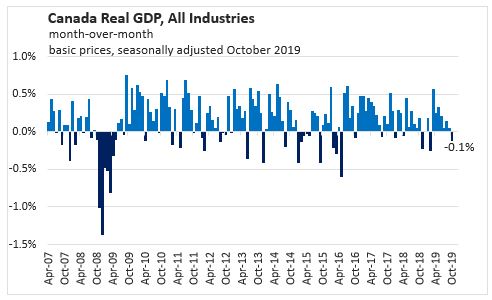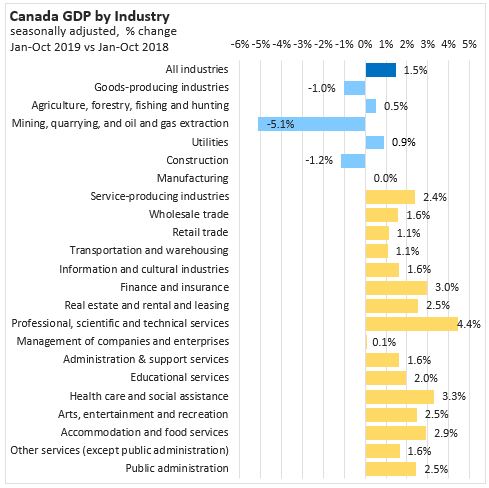The Economics and Statistics Division maintains archives of previous publications for accountability purposes, but makes no updates to keep these documents current with the latest data revisions from Statistics Canada. As a result, information in older documents may not be accurate. Please exercise caution when referring to older documents. For the latest information and historical data, please contact the individual listed to the right.
<--- Return to Archive
For additional information relating to this article, please contact:
December 23, 2019CANADA GDP BY INDUSTRY, OCTOBER 2019 
Real GDP in Canada decreased by 0.1 per cent in October, the first decline in eight months. Goods-producing industries decreased by 0.5 per cent and service-producing industries were virtually unchanged. Compared to October 2018, the Canadian economy is 1.2 per cent larger with an annualized value of $1,975 billion (chained 2012 dollars) in October 2019.

Agriculture, forestry, fishing and hunting decreased 0.2 per cent in October.
Oil and gas extraction was up 0.6 per cent. Oil sands extraction decline 3.1 per cent as synthetic crude oil production in Alberta was down due in part to maintenance at some of facilities, while oil and gas extraction outside of the oil sands increased 4.5 per cent as crude petroleum production at some North Atlantic facilities resumed. Mining and quarrying (except oil and gas) declined slightly 0.1 per cent in October, with declines in potash, copper, nickel, lead and zinc offsetting increases in iron ore, gold and silver.
Construction sector was flat in October as gains in non-residential construction and engineering and other construction activities were offset by losses in residential construction and repair construction. The rise in non-residential construction was led by an increase in commercial construction as public and industrial construction both edged down. The decline in residential was led by a decrease in alterations and improvements.
Manufacturing declined for the fourth time in five months as the sector declined 1.4 per cent. Durables declined in 8 of 10 subsectors, led by a decline in transportation equipment. Transportation equipment manufacturing declined due to lower activity driven by the United Auto Workers strike in the United States, leading some Canadian parts plants to scale back production. The decline in non-durables was led by declines in plastic and rubber products.
Wholesale trade was down 1.0 per cent in October. There were decreases in seven of nine subsectors. Farm products wholesaling rose 6.7 per cent, largely offsetting a 7.8 per cent decline in September when inclement weather across the Prairies delayed the harvest and affected exports of grains and oilseeds. Retail trade declined 1.1 per cent in October, its largest decline since March 2016.
Transportation and warehousing rose 0.6 per cent in October as eight of the nine subsectors posted gains. Air transportation led the growth with a 1.8 percent increase, the largest growth since June 2018. Rail transportation was down 0.2 percent following a decrease of 6.3 percent in September, as declines in October in intermodal and automotive car loadings more than offset gains from resumed movement of grains and fertilizers.
Finance and insurance was down 0.2 per cent in October. Declines in financial investment services, funds and other vehicles and insurance carriers, due to global trade tensions and market uncertainty, offset increases in depository credit intermediation and monetary authorities.
Real estate and rental and leasing rose on activity at offices of agents and brokers, mainly due to activity in the Greater Vancouver Area, Ottawa and Fraser Valley in British Columbia. Professional and technical services rose 0.3 percent.

Comparing the size of the Canadian economy in January-October 2019 with January-October 2018, there has been a 1.5 per cent increase due to higher service sector output (+2.4 per cent) while the goods-producing sector declined by 1.0 per cent. Higher levels of activity in agriculture, forestry, fishing and hunting and utilities partially offset the lower levels of activity in mining, quarrying, and oil and gas extraction and construction. Service sector output is higher across all subsectors, with the largest increases in professional, scientific and technical services, health care and social assistance, finance and insurance, accommodations and food services, public administration and real estate and leasing subsectors.

Source: Statistics Canada.
Table 36-10-0434-01 Gross domestic product (GDP) at basic prices, by industry, monthly (x 1,000,000)
<--- Return to Archive